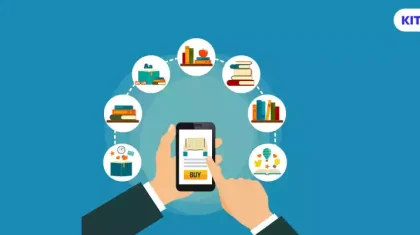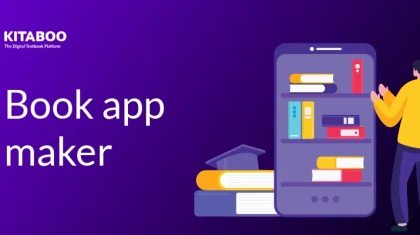
Revolutionize Your Learning with Top Interactive Software Tools
Summarize this blog with your favorite AI:
Today, any activity that has an interactive element is highly valued, both online and offline. Whether it’s a webinar, a learning program, or an offline event, emphasis is placed on making the content engaging for attendees.
The learning domain is also seeing a similar trend because interactivity enhances the absorption and retention of knowledge and, in turn, boosts learning effectiveness. Hence, more education publishers aim to make their content interactive. They are leveraging interactive learning software such as KITABOO to make content engaging for learners of diverse age groups.
This blog explores interactive learning software, the key types of effective interactive content, and the benefits of using such software tools.
TABLE OF CONTENTS
I. What is Interactive Learning Software?
II. Types Of Effective Interactive Learning Content
- Interactive Videos
- Leverage AI Tools
- Interactive eTextBooks/ eBooks
- Gamified Learning
- Augmented Reality (AR)/ Virtual Reality (VR)
What is Interactive Learning Software?
Interactive learning software is a single, unified interface that allows educational content publishers to create, publish, and distribute high-quality interactive content to their audiences cost-effectively.
Such software leverages several technologies, such as Artificial Intelligence (AI), Machine Learning (ML), robotic automation, and cloud computing, to create innovative interactive learning models designed to boost learning effectiveness among learners.
For example, the adoption of digital textbook publishing software such as KITABOO enables publishers to produce interactive eBooks and eTextbooks, which are revolutionizing education across fields.
Types Of Interactive Learning Content
By leveraging interactive learning software, publishers can incorporate the following types of interactive learning content that also helps expedite the achievement of learning goals:
Interactive Videos
While video is a popular multimedia element, interactive videos are gaining popularity in learning modules.
- Publishers can use bite-sized videos to help explain complex concepts within 30 seconds to a minute of viewing time.
- A storytelling narrative can be built up by enabling learners to watch videos in chronological order.
- Today, quizzes and tests can be embedded are various intervals in the video to help learners test their knowledge.
- The use of clickable hotspots is another effective way to visualize content and enable learning.
- Adding social elements, such as comments and sharing, further increases the interactivity of video content.
Leverage AI Tools
The introduction of Artificial Intelligence (AI) tools into the learning mix can further boost the effectiveness of interactive learning creation. A survey conducted among teachers, for instance, indicates that 75% claimed that the use of AI helped boost learner outcomes.
The adoption of interactive learning software tools enables education publishers to utilize AI in engaging ways, as follows:
- Automate the creation of individualized, interactive assessments for learners based on their progress.
- Personalize learning content based on a student’s real-time skill and knowledge.
- Analyze a student’s progress and generate reports and real-time feedback in a consumable format.
- Recommend relevant learning resources for learners as per their progress.
- The use of AI-powered chatbots is now helping learners get instant guidance and solutions as per their needs.
Interactive eTextBooks/ eBooks
One of the fastest-growing interactive content verticals is interactive eBooks. Digital learners prefer interactive learning content over physical textbooks and text-heaving eBooks.
Interactive eBooks come with the following advantages:
- Learners can access multimedia content such as videos, slides, audio representations, and hotspots, which are related to the content. These elements make learning more engaging.
- eBooks can feature interactive quizzes and polls to help learners assess their knowledge levels at regular intervals.
- Features such as search, highlights, comments, and real-aloud make learning more collaborative, inclusive, and interconnected.
Publishers can leverage cloud-based, automated, collaborative authoring tools such as KITABOO to produce and distribute high-quality interactive eTextbooks and learning content for a wide spectrum of learners. The platform also provides a downloadable eReader app to provide a quality reading experience to users.
Gamified Learning
Popular gamification elements can now be seamlessly and effectively applied in non-gaming contexts, such as learning. This approach increases engagement, excitement, and healthy competition.
Here are some key ways to build gamified content:
- Bring fun storytelling, characters, and visual and audio elements to the entire learning experience.
- Award badges and institute a points system to nudge learners to finish learning and move to new levels of achievement.
- Introduce leaderboards that allow learners to track progress and see how they are performing vis-a-vis their peers.
- Incentivise learners to spend more time learning by unlocking fresh content as they achieve new milestones of learning.
Augmented Reality (AR)/ Virtual Reality (VR)
Today, AR and VR technologies are transforming learning by providing an immersive learning experience to students across many domains.
- Virtual environments can be created and students can experience a subject up and close. For instance, by generating a virtual environment of the Milky Way, learning about planets and stars can be made more engaging.
- AR goes a step further by introducing multiple sensory elements, such as auditory, olfactory, and visual, to provide a holistic experience. This approach can be used in fields such as medicine to help students gain hands-on experience and retain knowledge faster.
Today, AR and VR are being used in a wide range of fields, such as medical training, engineering, and astrophysics, to expedite the learning process and create a more realistic experience.
Benefits Of Interactive Software Tools
Here’s a look at how publishers can benefit from using state-of-the-art interactive software tools when building learning content.
Automate Creation, Publishing & Distribution
Publishers can automate the entire workflow of producing interactive learning content, thus reducing inefficiencies and errors. The process enhances collaborative abilities and frees up bandwidth of team members to focus on strategy.
Cost-Effectiveness
Publishers can go to market with new projects, function with lean teams, and reduce inefficiencies in the publishing cycle.
Superior distribution mechanisms also enable publishers to drive revenues. These outcomes collectively contribute towards enabling content development operations to be more cost-effective.
Enhances Learning Effectiveness
Learners are more likely to stay engaged when the content is engaging and interactive.
Access to high-quality learning content enables quick absorption and longer retention of concepts. Self-learning is also an important outcome, as learners become more self-reliant and motivated to learn.
The Takeaway
There’s a growing trend towards making learning content more interactive due to the enhanced learning effectiveness of this learning mode.
Educational providers making early investments in accessing the right interactive learning software can stay innovative, competitive, and relevant to their audiences. They can build a foundation for delivering high-quality, interactive, accessible content and establish their niche in the education domain.
Today, publishers of education content can partner with digital textbook publishing platforms like KITABOO to create, publish, and distribute high-quality interactive training content to global audiences. Our cloud-based digital publishing platform is available in both a licensed version (one-time purchase) and a flexible subscription model.
Contact us to know more!
Discover how a mobile-first training platform can help your organization.
KITABOO is a cloud-based platform to create, deliver & track mobile-first interactive training content.



